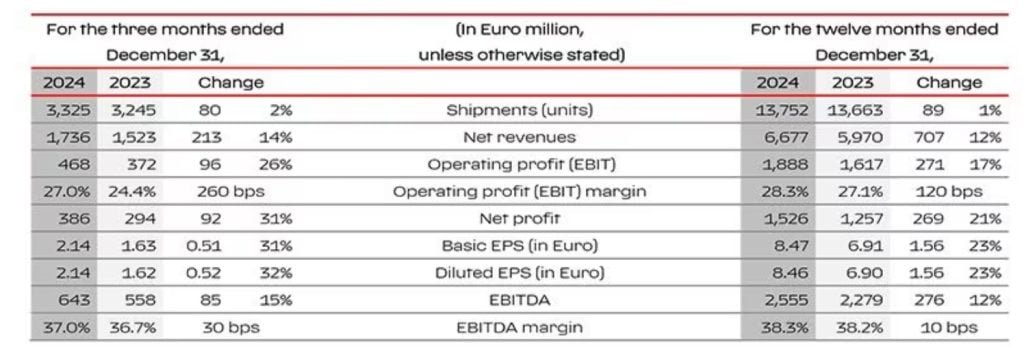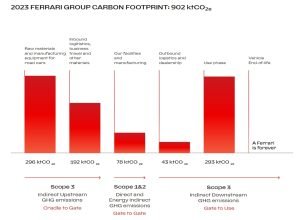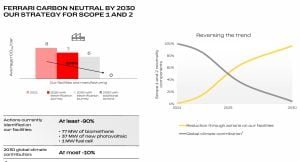The iconic luxury carmaker posted stellar growth in the fourth quarter while driving forward its sustainability goals. Ferrari’s exceptional financial performance in 2024, was fueled by strong revenues and effective market strategies.
Benedetto Vigna, CEO of Ferrari remarked on their glorious performance noting,
“Quality of revenues over volumes: I believe this best explains our outstanding financial results in 2024, thanks to a strong product mix and a growing demand for personalizations. On these solid foundations, we expect further robust growth in 2025, that will allow us to reach one year in advance the high-end of most of our profitability targets for 2026”
He further added,
“Last year’s results reflect a great teamwork that involved all our Company’s souls. This teamwork was also visible in a very competitive racing season. The will to progress that has always characterized Ferrari has led to innovation in our infrastructure, with the inauguration of the e-building; in our products, best highlighted by the new supercar, the Ferrari F80; and in R&D, with the new E-Cells Lab that will further strengthen our electrochemical knowledge to prepare us for the future. And we will reveal more of our future on 9 October at our Capital Markets Day.”
Ferrari Reports Strong Growth in 2024 Earnings and Revenue
Ferrari’s net revenue surged to €6,677 million in 2024, an 11.8% increase compared to the previous year. Its net Q4 revenue was €1,736 million. The contributing factors for revenue boom were:
- Cars and Spare Parts: Generated €5,728 million, up 11.9%, driven by a richer product mix, strong demand, and personalized options.
- Sponsorship and Brand Revenues: Rose 17.1% to €670 million, thanks to new sponsorship deals and lifestyle initiatives.
- Other Revenue: Stayed stable. Higher-income from financial services balanced the end of the Maserati contract in 2023.
The company reported an industrial free cash flow of €1,027 million. This shows its strong operational efficiency.

Higher Profit Margins
Ferrari achieved an operating profit (EBIT) of €1,888 million, a 16.7% increase over the previous year, with an EBIT margin of 28.3%. Net profit climbed to €1,526 million, and diluted earnings per share (EPS) stood at €8.46.
The company’s EBITDA rose 12.1% to €2,555 million, maintaining a robust margin of 38.3%.
Rise in Shipments
Ferrari shipped 13,752 cars in 2024, reflecting a modest 0.7% growth compared to the previous year. The increase was driven by strategic allocation across regions. Shipments in the EMEA region rose by 141 units, while the Americas added 192 units. However, this growth was partially offset by a decline of 328 units in Mainland China, Hong Kong, and Taiwan.
Meanwhile, the Rest of APAC region saw a slight increase of 84 units. The deliveries had ten internal combustion engine (ICE) models and six hybrid models. Hybrids made up 51% of the total shipments. This balance highlights Ferrari’s focus on innovation and sustainability while maintaining its signature performance.

Ferrari’s 2024 results showcase its ability to grow revenues, profits, and cash flow while maintaining exclusivity and innovation in its offerings. The company remains a benchmark in luxury performance.
EV Debut: What’s Next for the Iconic Brand?
Reuters reported that Ferrari will launch its first fully electric car on October 9 at its Maranello headquarters in Italy. CEO Benedetto Vigna announced the landmark debut, marking a bold shift from the brand’s signature petrol-powered engines. The event will take place during a capital markets day, kicking off the fourth quarter as planned.
The highly anticipated EV is one of six new models Ferrari plans to roll out this year. Despite global uncertainties, including U.S. trade policies, Vigna emphasized that the company’s plans remain on track.
China is a booming market for electric vehicles due to lower taxes and strong demand. This offers significant potential for Ferrari’s new EV. Ferrari’s new EV stands to benefit greatly. Vigna hinted that Ferrari’s sales cap policy changes in China will be announced at the October event. This could open up more opportunities in this important market.
Ferrari hopes to increase revenue and core earnings by at least 5% this year with this launch. This shows their confidence in an electrified future.
- READ MORE: Volvo Gives Carbon Pricing a Go While Audi, BMW, Mercedes-Benz Also Lead the Green Charge
Ferrari’s Journey to Zero Emissions by 2030
Ferrari, a name synonymous with speed is also driving toward sustainability. It aims to be carbon neutral by 2030 by primarily cutting greenhouse gas (GHG) emissions in operations and the supply chain. It also embraces renewable energy and encourages community involvement.
Emission Reduction Goals
As per its latest sustainability report, in 2023, the company achieved a 7% reduction in Scope 1 emissions compared to 2022 with the electrification of its Maranello plant. Scope 2 emissions (market-based) stayed the same. This was due to ongoing investments in renewable energy. However, switching from natural gas to electricity caused location-based emissions to rise.
In total, Ferrari’s direct and energy-related emissions i.e. Scope 1 and Scope 2 amounted to 77,691 tCO₂eq in 2023, down from 84,012 tCO₂eq in 2022. Additionally, the company is focused on improving energy efficiency and these reductions show its commitment to eco-friendly practices at its production sites.


Other key air emissions come mainly from volatile organic compounds (VOCs) released during vehicle production. The company also keeps a close watch on emissions of nitrogen oxides (NOx), sulfur oxides (SOx), and dust to ensure continuous monitoring and control.

Its decarbonization efforts go beyond its factories. They also tackle Scope 3 emissions from raw materials and vehicle use. The strategy includes:
- By 2030, at least 50% of Ferrari’s vehicle offerings will be hybrid or electric, reducing CO2 emissions per car by half.
- The company plans to use recycled aluminum to cut raw material emissions by 30%.
Green Energy and Carbon Reduction Initiatives
Ferrari is integrating cutting-edge technology to lower its carbon footprint:
- Fuel Cell Technology: In June 2023 it installed a 1 MW solid oxide fuel cell plant at its Maranello facilities, powering 5% of Ferrari’s production. This cuts gas use by 20% and reduces smog-causing pollutants by more than 99%.
- Photovoltaic Systems: In July 2022, Ferrari collaborated with Enel X to expand solar energy production. They planned to install a new solar power system on the roofs of their Maranello factory. This system used 3,800 panels that were capable of generating 1,626,802 kWh annually, saving 740 tonnes of CO2 emissions per year.
- Renewable Energy Community (REC): In May 2023, Ferrari launched Italy’s first Renewable Energy Community (REC) in Maranello and Fiorano with Enel X. A 1 MW solar system on Ferrari’s land will supply clean energy to help local communities and promote sustainable development.

Replacing Gas with Renewables
Ferrari’s decarbonization journey doesn’t stop here. Last year in October it retired its gas-powered trigeneration plant three months early. This facility has supplied electricity, heat, and cooling energy since 2009. Notably this closure will reduce methane gas consumption by 70% and cut Scope 1 and 2 emissions by 60% annually.
The luxury car maker also plans to double its solar power systems. This will help it reach a peak capacity of 10 MW by 2030. This move will cut down its reliance on fossil fuels even more.
Ferrari’s Verra-Certified Carbon Credit Strategy
Carbon credits play a key role in supporting its 2030 carbon-neutral target. Ferrari invests in Verra-certified projects that follow the Verified Carbon Standard (VCS). This ensures its offsetting efforts are credible, clear, and effective.
The company teamed up with ClimateSeed for a carbon avoidance project in Quebec, Canada. This project includes over 800 local micro-projects. It involves SMEs, NGOs, and municipalities working together to reduce greenhouse gas (GHG) emissions. They work on boosting energy efficiency, redirecting landfill waste, and using cleaner fuels.
In addition to carbon credits, Ferrari launched Bosco Ferrari, an initiative to establish a forest in Italy. This project promotes biodiversity and offsets emissions locally, complementing its global decarbonization efforts.
Economic growth from environmental impact

All these efforts show how seriously the carmaker takes climate action. Ferrari takes climate action seriously, setting a standard for sustainability in the automotive industry. At the same time keeping their legacy of excellence.
The post Ferrari’s Road to Glory: Massive €1.74 Billion Revenue Boom and Net Zero Goals Aligned appeared first on Carbon Credits.

